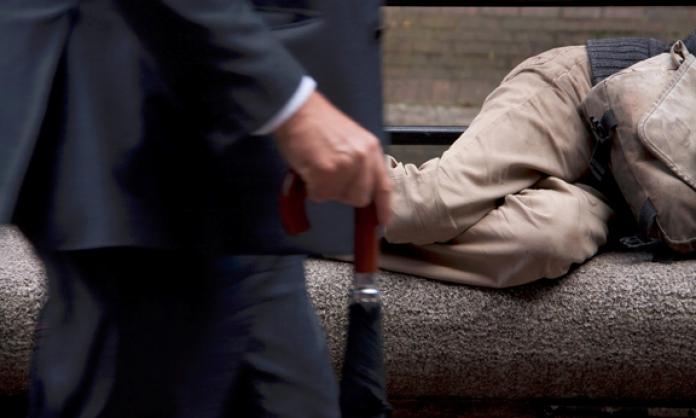“This idea that people and inequality and incomes has [sic] been going in the wrong direction. That’s not borne out by the facts. It hasn’t got worse, inequality. It’s actually got better.” So contended that man of the people cum treasurer Scott Morrison on the ABC’s 7:30 program.
This mad claim makes more sense when considered in the light of what appears to be the Liberal Party’s definition of inequality. The Liberal member for Bowman, Andrew Laming, summed it up this way: “Inequality is staring over a fence and noticing another guy has got a jet ski and you don’t have one”.
Now I’m as inclined as the next person to be plunged into a vortex of envy and self-loathing at the sight of a neighbour’s newly acquired recreational equipment, but I’m not sure this is sufficient to explain the growing worldwide hatred of the gross inequality of modern capitalism.
More pertinent are the fences you can’t even get close to because they are monitored by state of the art, military grade CCTV surveillance systems. And the wealth they’re protecting is not the kind you can readily observe parked in the garage or moored at the local jetty.
It’s the kind you need a forensic accountant to find. Like the $32 trillion the Tax Justice Network estimates wealthy individuals, including Malcolm Turnbull, have stashed in tax havens such as the British Virgin Islands. Indeed, look over the fence of Turnbull’s $19 million Point Piper mansion and you won’t see his $200 million investment portfolio parked in the garage, or numerous investment properties – including multiple residential properties, four office units and 20 pastoral holdings – stored neatly in the shed.
Of course, the Liberal government wants to trivialise and demean concerns about the concentration of wealth in the hands of an ever shrinking minority because it wants to pursue an economic agenda geared towards achieving this very outcome. It does this by appealing to the worn-out, reheated clichés and less than compelling metaphors of trickle down economics: that if we all get behind policies geared towards further enriching the extremely wealthy, we’ll all benefit. A rising tide lifts all boats, as Joe Hockey so lovingly reassured us.
But if ever there should be some real evidence of the veracity of this worn-out old theory, it should be now.
The Australian economy has experienced the longest period of uninterrupted growth in its history. In April, it broke a world record: 104 quarters of growth without recession is the longest period of growth any capitalist economy has achieved. Even during the global economic crisis between 2008 and 2013, the Australian economy continued to expand; in fact, it enjoyed the second highest rate of growth of all the 35 OECD countries.
Profits are also at record highs. “Manufacturing profits in the 2017 first quarter were the highest in six years”, wrote Alan Austin at Crikey last month. “First-quarter profits in financial and insurance services were up 170 percent from the profits in the same period last year. Combined profits for the last two quarters were $3,200 million, the highest in eight years.
“Mining profits for the last two quarters – the fourth quarter in 2016 and first in 2017 – were $56,485 million, the highest in Australia’s history. First-quarter profits in rental, hiring and real estate services and also in transport, postal and warehousing were both best ever.”
This has been assisted by pro-corporate policy of successive Australian governments, key to which have been massive tax cuts and concessions for wealthy corporations. Indeed, despite the record economic growth, government revenue from company tax has stagnated over the last decade. A mere $68,700 million was collected over the last financial year, about 10 percent more than that collected ten years ago in the 2007-8 financial year. If the effective collection rate today were the same as then, revenues from company tax would be double their current amount.
So the government has pursued pro-corporate economic policies while the rich have raked in profits. Has any of this “trickled down” to the millions of wage workers in Australia?
It seems not. Wage growth is at 1.9 percent per year, according to the Australian Bureau of Statistics, the lowest it has been since the last recession, in the early 1990s. The income of median households is rising at only a quarter of the rate of the richest 20 percent. And, according to the Australia Institute, the proportion of GDP going to wages (46.2 percent) is at the lowest level since 1959, the year the ABS began keeping records. Added to this, housing, a basic necessity, has never been more unaffordable. An economy that is setting world records with its growth is increasingly failing to fulfil the most basic needs of the human beings subject to it.
And to keep public money flowing towards corporate handouts and subsidies, the vital services and payments people rely on to survive have been cut or run down. Unemployment entitlements are impossible to live on, and the system that administers them is increasingly punitive. Successive governments have tried to cut back old age pensions and force the elderly to sell their one asset in order to receive proper care in their old age.
We’ve been waiting 40 years for the “trickle down” or the “rising tide”. It never comes. The hard truth of it is that wealth has to be prised from the grip of the super rich; waiting doesn’t work. The fanciful, self-serving spin that passes for economic theory in the decrepit institutions of capitalist rule is long past its use-by date.









